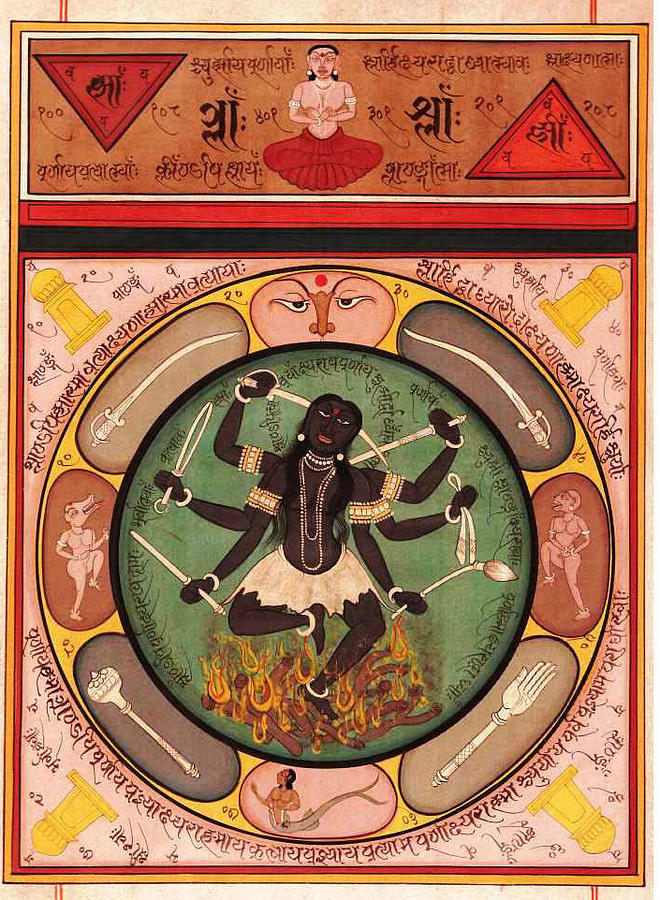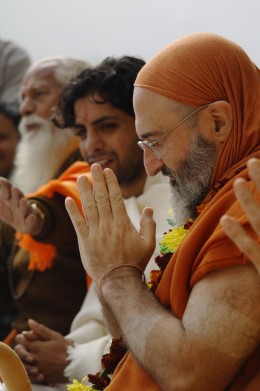People those adhered to Vedic faith in India, before British empire had tightened its final rule, were living a kind of normal life. They did not have to encounter any psychological dilemmas as to who were they. They never needed to find their own roots. Over the millennium they had established themselves as chief priests of not only Vedic but non-Vedic societies (Shudras and Ati-Shudras to them) as well.
They even could deny coronation of King Shivaji until he proved his royal (Kshatriya) bloodline. The fact was Kshatria varna never had any Vedic sanctions except for the later Smrities. However, unless one would prove to be Vedic, he couldnt have any Vedic ritualistic rights. They had enforced ideas of Varna system upon non-Vedic society and would decide the non-Vedic religious matters on Vedic principles in British era. Prior to that the Smritis remained limited to only the Vedic society. However, the Vedics enjoyed high status and would forever as was written in Smritis and Puranas. They needn’t think of their origin as Vedas had declared them to be born of Lord’s head. The meaning of the Vedic verses was as if the propriety of the Vedic priests. However, they always were aware of the fact that their religion is distinct and it has no relation with the Hindu religion, whatsoever. But so far there was no racial tint to their supremacist schemes.
However, first, it was Bopp followed by Max Muller to propose Aryan Invasion theory in the middle of the nineteenth century. The theory made havoc in Indian society, especially Vedic Brahmin. They thought they were part of an ancient race named Aryan which was mighty, brilliant, progenitors of Sanskrit language which later became the mother of all Indo-European languages and conquerors of Indian aboriginals. Those were victorious Aryans those enslaved and enforced caste system upon the aboriginals. Unfortunately, they fall for the prey without understanding the conspiracy. Rather overjoyed by the invention (?) they could not foresee the trap. They suddenly started to find their roots in Eurasia and looked down at the local populace as enslaved ones in newborn enthusiasm. The religious divide thus became racial divide. It was a dangerous situation they were entering into, but the scholars like Lok. B. G. Tilak rather contributed to the theory boosting egotism of the Brahmanical (Vedic) society of India.
The theory naturally had fitting reaction from non-Vedic Shaivait society. Jotirao Phule declared Brahmins as outsiders, vicious and savage people those cunningly won indigenous Asura society putting them in lowest social order so that they could rule them unobtrusively. There was nothing wrong in Mahatma Phule’s argument. He ruthlessly lashed Vedics for their principles of inequality and religious supremacy. Non-Vedics too started to find their own roots independently as they found Vedic scriptures were of no help to them to find their own past. The original Asura cultural theory rose up naturally to encounter Vedic Aryan Theory. In a way, Aryan Invasion theory became the main cause of the racial divide in the Indian subcontinent.
Vedics could see the trap of the European scholars not until the middle of the twentieth century. They were actually fascinated with the term “Aryan.” The term itself made them racially superior and a born to rule elite class. And yet approving to the foreign origin too was becoming dangerous as Dravidians and other Shudra (originally a name of a tribe, forced later on the Non-Vedics) thinkers and political leaders were constantly agitating against them.
Without abandoning the term “Aryan” they suddenly took U-turn and started stating that the Aryans were indigenous. RSS chief blatantly declared that the North Pole was situated at Varanasi in ancient times so Aryans too were originated in the vicinity of holy Varanasi. This argument was unscientific hence it received scathing attacks and forced RSS to abandon this theory. Still, they wanted to prove anyhow indigenous Aryan theory at any cost.
Self-declared scholars like Shrikant Talageri, Michael Danino, and Stephen Knap etc. recently came to their rescue. Talageri painstakingly, sometimes breaking the basic rules of history writing, misinterpreting the Rig Vedic history, tried to prove that the Vedic Aryans moved from East Punjab to Afghanistan and then onward some branches spread Indo-Aryan languages in Europe. Danino and others tried to link the Ghaggar River to the Vedic Sarasvati River thus not only try to prove Vedic Aryans were indigenous but progenitors of Indus culture. The vague proofs misinterpreted and misrepresented though became popular in the Vedic society of India and abroad, but the claim never did prove on scientific grounds.
What is their problem? Why they still are searching their roots? Why they also use the genetics to conveniently prove their Eurasian or indigenous bloodline?
The problem is with their superiority complex nourished by a grand falsehood. The problem is with their desire to maintain dominance of so-called Vedic culture. The problem is with their own misunderstanding of their own self. They do not want to see clearly what they are, though the abundant proofs show they too are ordinary people, converts and if something special has happened in the cultural history of the country the major contributors are non-Vedic society in various forms…right from architecture to various branches of art and science. They had minor or no participation in it except reciting Vedas and other scriptures, adding to it, corrupting it generations after generations. Whatever discoveries can be attributed to them was always part of their religious requirements. Lack of prominent heroes in Vedic society they compensated by thieving non-Vedic heroes with garnering Vedic elements to their characters. Rama, Krishna and even Parshurama were never part of Vedic society or religion. The deliberately added Vedic elements to their characters are so obvious that they can be very easily detected! What made them do this?
Still, they want the credit of everything that is excavated from the remote past! Isn’t it insanity? Craziness?
The identity crisis of Vedics is self-inflicted. It is just an outcome of their superiority complex nourished from centuries. And as yet they cannot tell for sure to which land they belonged. What is their real contribution to the Indian society and culture? What was their race? How old really are their scriptures like Rig Vedas? Why and under what circumstances they abandoned their own Gods and worshipping non-Vedic gods? What proves their victory over aboriginals and their enslavement and forcing castes (professions) on them?
They do not have answers to these questions. If at all they want to answer these questions they twist and distort the things and somehow manage to escape without giving convincing answers with the proofs to the satisfaction of other people. They do otherwise. They misrepresent the facts. This way they not only deceive others but themselves. And this is more dangerous!
Who are Vedics? Vedicism just is another religion amongst others. It has been proved on all grounds that the Shaivait tradition has been anterior to all other religious traditions of India which still remains practically dominant in the country. The Vedicism, based on four Vedas and various Smritis, having its own ritualistic structure is an independent religion. There is no common factor including philosophy that anyway can even remotely connect both the religions.
Then why they shy away from calling them Vedics as a separate independent religion? Why they want to hide their self in disguise of Hinduism? Why they get terrified or agonized when told that you have the different and distinct religion and do not commit blasphemy by calling yourself Hindu?
They do not know for sure from where they have come. They are not sure exactly what religion they have today. They want to play in both the religions and that too as a leader. They want to keep their own religion and its practices to themselves and yet want to grab whatever benefits them from other distinct religion.
Let us not forget here that India had been the secular country from ancient times. This is why many religions took birth and could spread their messages unobstructed in the country. The Kings and magnates have patronized all the existing faiths. Not that there hadn’t been any religious skirmishes, but still they are not as violent as we find in western history. People too have seen revering other faiths as well while practicing their own. There have been religions those had many factors common and yet they maintained their independent existence, such as Jainism and Buddhism. Actually, there was nothing common between Vedicism and Shaivism. It is Vedicism which always had been unsympathetic towards Buddhism and Jainism. Ardent opponents of Lord Shiva and his religion, its idolatry, from the Rig Vedic times, it is a massive shift of Vedics by entering the Shaivait religion as priests. Historically speaking, the need of the time, survival, forced them to change their own religious stance. The secularity of the people didn’t mind but they did not know they are inviting an evil inside their home.
The society experienced it. They were degraded from their own position of the social equality and an eternal curse of the inferiority shrouded them forever.
Still…Vedics do not admit that they are bi-religious people. They still want to hold their positions as religious and cultural leaders forcing Vedic culture on Non-Vedic people creating fraudulent stories of Vedic origin of everything! Then why they do not admit they are Vedic?
This is because they have the psychological disorder. Just to maintain their hegemony they keep on harping the greatness of the Vedas and when questioned they try to impress that the reading of the Vedas is incorrect! However, their own readings vary with the changing scenarios and they don't mind to it for it suits their purpose! This just is a mockery of the scientific methods. Who will safeguard their interests? They shy away from admitting that they are Vedics when among Hindus but keep on harping on the Vedic superiority to maintain their hegemony. They always are on a quest of finding their original habitat which has been changing constantly from one place to another!
Vedic people need to come out of this identity crisis and look at the things with naked eyes without nourishing any Vedic prejudices. The ordinary Vedics are getting confused day after day and they do not know what kind of relationship they want to maintain with the Hindu, i.e. Non-Vedic people. Some time they go offensive...some time defensive...but this is not going to help them to avoid scathing attacks from non-Vedics. How to solve the problem is up to them...





